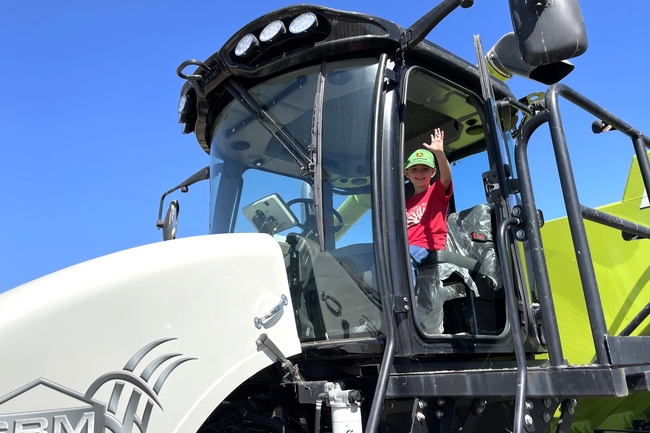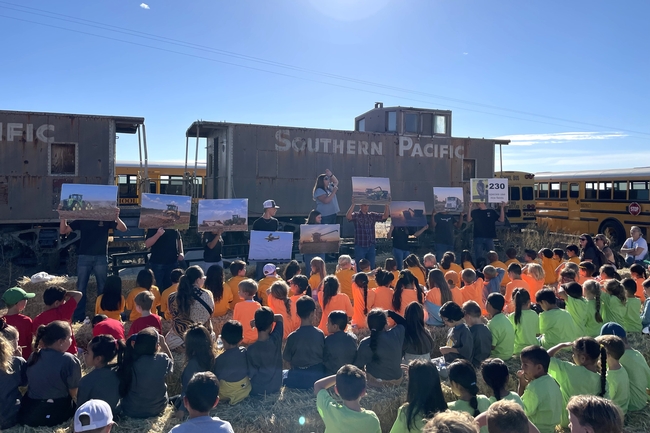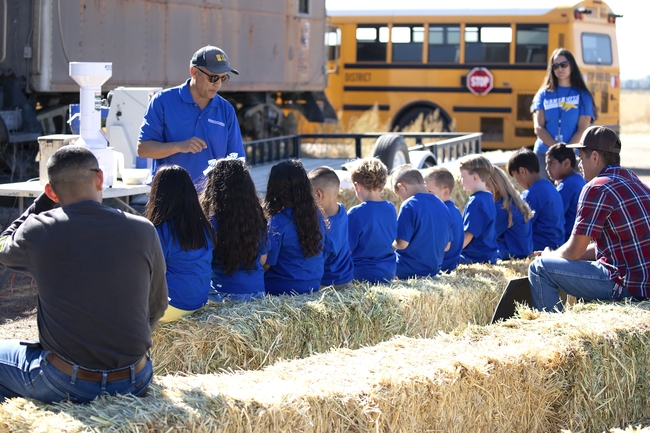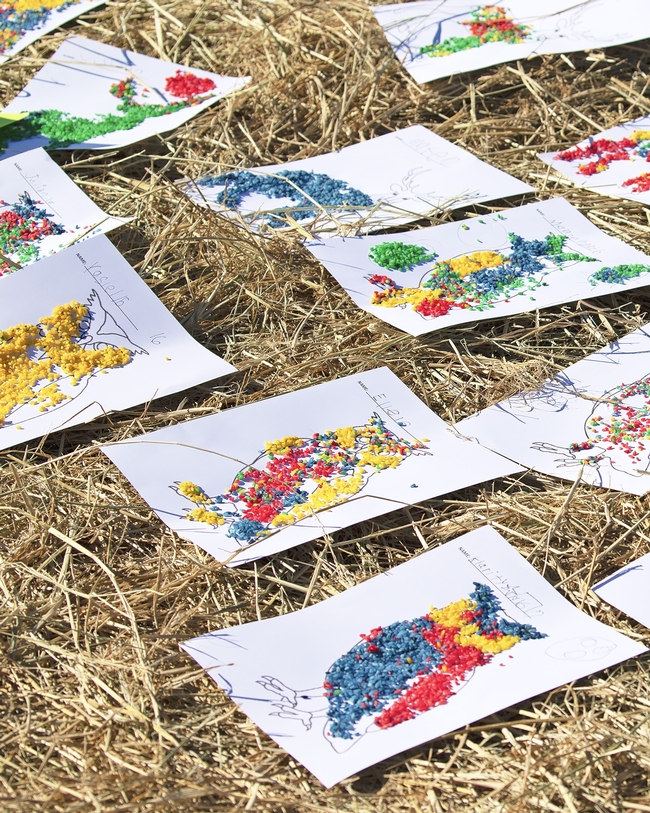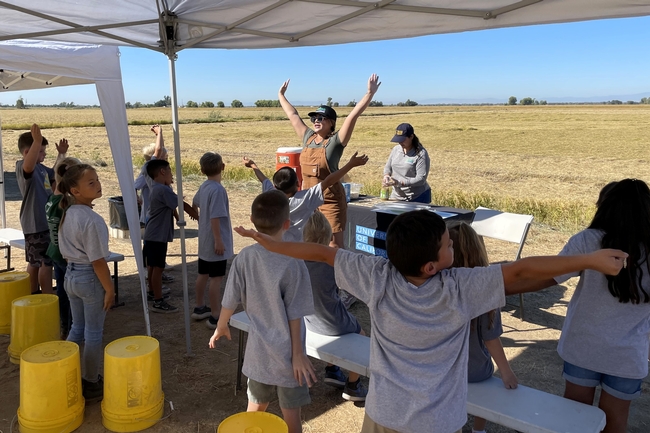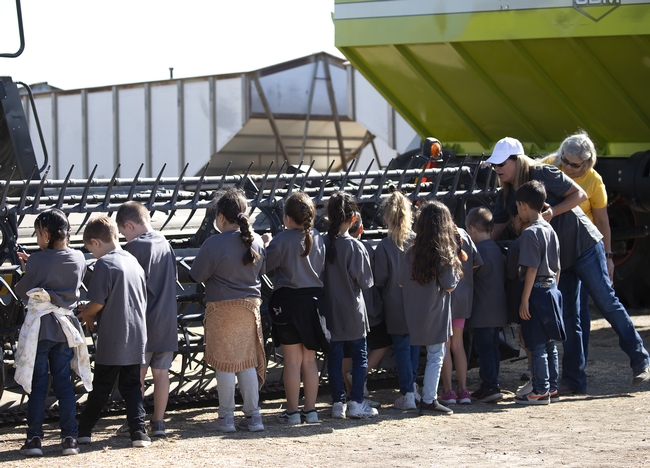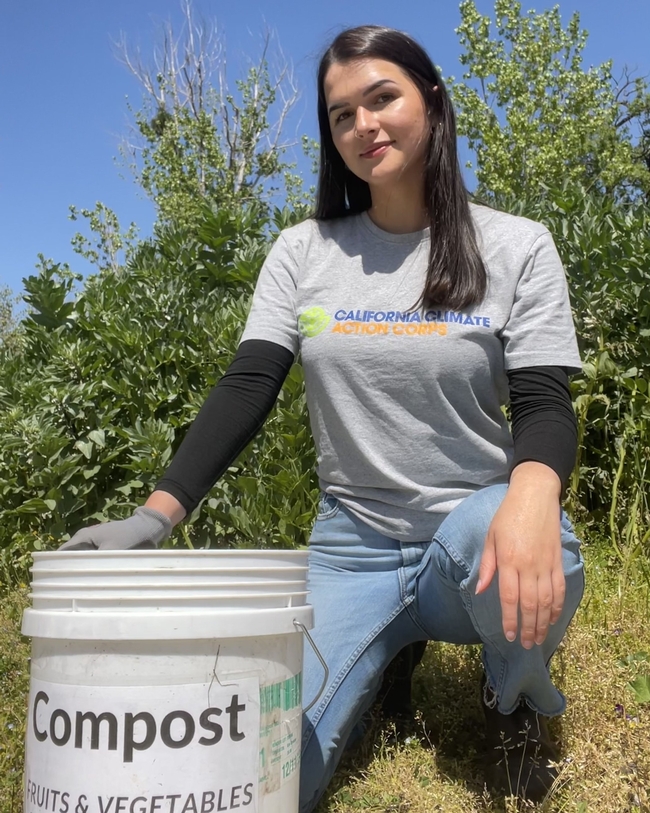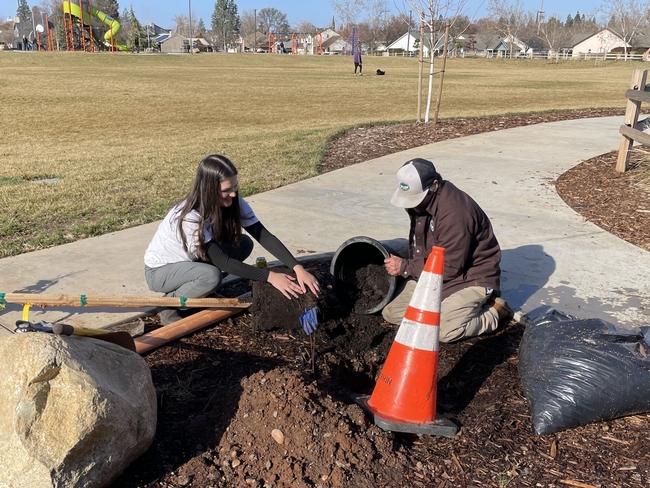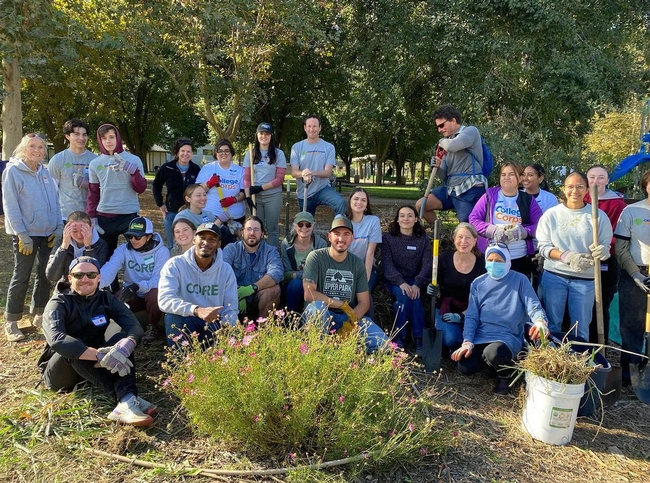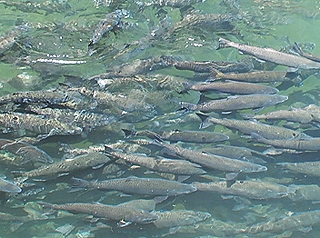Posts Tagged: Butte
Butte County first graders enjoy ‘ricetastic’ day at local farm
UC Cooperative Extension advisors, educators join growers in showcasing rice production
When Tracy Schohr volunteered in her son's pre-K class a couple years ago, she was stunned to find out that only two of the 20 children had ever been around a tractor. And this was in the rural Butte County community of Gridley, in the heart of California's rice-growing region.
Seeking to introduce more young children to agriculture, Schohr – the University of California Cooperative Extension livestock and natural resources advisor for the area – and her friend Lisa Donati created an event to showcase rice farming.
After the debut of “Ricetastic Day” last year with about 140 students from Gridley in attendance, this year's event on Sept. 19 attracted more than 240 schoolchildren – this time from across south Butte County.
First graders from McKinley Primary School in Gridley, Manzanita Elementary School, Biggs Elementary School and Richvale Elementary School – along with their teachers and many family members – enjoyed hands-on experiences at Schohr's rice and cattle ranch.
“There's a dwindling population that produces the food that we eat across America, so how can we have more people know, appreciate and love agriculture if we don't give them that opportunity?” said Schohr. “That's what this day is really about – to teach them about rice, to teach them about their community, how healthy rice can be, and how the farming and ranching can also create habitat for wildlife. It's all-encompassing.”
Event stations share different aspects of rice
Schohr, who grew up on the family ranch in Gridley, remembers coming with her McKinley schoolmates for a visit. But those field trips had comprised only lunch and a quick “drive-through” tour of the historic farming operation.
For Ricetastic Day, however, Schohr organized – with generous help from local growers and community partners – a more comprehensive half-day of activities. After her brother, Ryan Schohr, welcomed the participants to the family farm, the students formed groups that were led by Gridley FFA youth on a rotation through a variety of stations.
At the milling station, Luis Espino, UCCE rice farming systems advisor, demonstrated how his mini mill machines remove the husks from rough rice to make brown rice, and then polish away the bran layer to make white rice. He had the children see and feel the difference as the rice moved through processing.
“I didn't even know brown rice existed!” exclaimed Elsie, a first grader at McKinley.
A native of Peru, Espino came to study agriculture through his lifelong fascination with biology and living things – and he said events like Ricetastic Day can inspire a similar passion in young people.
“It might spark their curiosity so that they might go into these areas of work in the future or have a career in agriculture, when they see that people do this for a living,” Espino said.
Ray Stogsdill, another McKinley school alumnus, returned to Gridley after college to pursue just such a career. A staff research associate in the lab of UC Davis professor Bruce Linquist, Stogsdill manages on-farm rice variety testing across the region. He volunteered to help Schohr with Ricetastic Day by talking about some of the heavy equipment and providing his perspective for the kids.
“They drive by the fields and they don't know what's out there,” he said. “This gives them a chance to know what they're driving by, so they can say, ‘We have rice here and this is how it works; this is how it grows.' It gives them an idea of what's going on around them.”
Where rice fits within a healthy diet was the focus for the CalFresh Healthy Living, UC Cooperative Extension team, comprising nutrition educators Sunshine Hawjj, Joanna Aguilar and Kenia Estrada, as well as community nutrition, health and food security advisor Veronica VanCleave-Hunt. They talked about how rice – like other grains in that vital food group – gives people energy, and then taught the students an energetic “ricetastic” movement activity.
“Because our program is part of UC Agriculture and Natural Resources, it's important to make the connection between where our food comes from and how it gets on our plate – especially with young kids, so that we can promote value for our local agriculture and our food systems,” VanCleave-Hunt explained.
Activities spark further conversations, learning about agriculture
With rice harvest late due to late planting in the spring, Eric Waterbury of Waterbury Farms was able to take some time to attend the event. Although his family has been growing rice for three generations, he said he appreciates opportunities for the broader community to see all aspects of his work – from the equipment to the processing.
“If the kids walk away from this with one thing, I hope it's that they realize every time they have a meal, somebody was out there working hard to provide that meal,” he said. “It wasn't just the person at the grocery store that provided it for them.”
Schohr added that Ricetastic Day was only possible through the support of the community. Butte County Farm Bureau and Natural Resources Conservation Service staff helped kids make art with colorful dyed rice; neighboring farmer Tinker Storm described how the harvester and “bankout” wagon work; and rice farmers Shelley Beck and Sue Orme read aloud “Daddy's Got Dirt: A California Rice Story,” a children's book written by a local rice grower.
With rice at the center of physical activities, arts and crafts, and science lessons for the day, the students learned a lot to take home.
“It's nice that the kids got these hands-on learning experiences,” said Ryan Schohr, “so they can go home tonight and, at the dinner table, talk about it with their parents or brothers and sisters, over dinner or over homework – and share what they learned here on the farm and about their community.”
Rebecca Christy, a first- and second-grade teacher at Biggs Elementary, said she is excited to return to the classroom and hear from her students about all that they learned during the day.
“Every morning right now I'm seeing the big trucks going by our school, and so I'll be able to point that out to them, ‘Where are they going? What are they doing?'” she said. “I can't wait to get back to school and let them tell me about all of this.”
One of her students, Ximena, was finishing her brownbag lunch as the group watched one of the Schohr Ranch harvesters rumble over the field. Despite enjoying a rice cake and a rice cracker earlier, she said her meal was missing one thing.
“Where is my rice, Miss Christy?” she said. “I want rice!”
UC Climate Steward: ‘It’s the most fulfilling work’
Climate Stewards course instructor inspires change in Butte County
Growing up in Butte County, Rose Brazil-Few has watched climate change devastate communities and ecosystems in the form of severe drought and deadly wildfire, including the 2018 Camp Fire that swept through Paradise. Through the University of California Climate Stewards program, Brazil-Few is taking action in her home county – and inspiring others to help.
“Seeing the environmental situation firsthand in California, every day I find a reason to work on climate action projects,” she explained. “It's the most fulfilling work that I could possibly be doing right now.”
As a California Climate Action Corps Fellow (a workforce development program affiliated with California Volunteers), Brazil-Few is working at the Butte Environmental Council as community sustainability coordinator. She said the UC Climate Stewards course she completed last fall – administered by the UC California Naturalist program – taught her crucial lessons she applies every day, especially on framing and conveying the climate crisis.
“One of the biggest takeaways is how to communicate about climate change while we're doing climate action work,” she said. “Sometimes you encounter community members who don't necessarily like the term ‘climate change,' but they still believe in cleaning up parks and planting trees for shade – so focusing on positive action will still accomplish your bigger goals.”
Brazil-Few will further amplify those locally rooted solutions and climate stewardship opportunities when she starts teaching her own UC Climate Stewards course this summer, through Butte Environmental Council.
“Rose is the first CCAC fellow to become a certified Climate Stewards course instructor as part of the Pathway to Leadership we co-developed with CCAC,” said Sarah-Mae Nelson, UC Climate Stewards academic coordinator. “This pathway is an opportunity for fellows to continue fostering community and ecosystem resilience in their communities as active Climate Stewards, once their official fellowship has ended.”
Since launching in fall 2020, nearly 500 people have completed the UC Climate Stewards course, which is delivered by 17 partner organizations throughout the state. Nelson noted that, in addition to the CCAC collaboration, UC Climate Stewards is also working with Sustainability Service Corps and SEI (Strategic Energy Innovations) Climate Corps – and looking into bringing the course to other states.
A 2021 graduate of Humboldt State University with a bachelor's degree in environmental studies, Brazil-Few said she appreciates that the UC Climate Stewards course instills a sense of hope and empowerment and possibility.
“I know some people who feel hopeless because there's such a focus on the doom of climate change – when in reality you can find so many programs and people in your local community making positive change,” she said.
In her community, Brazil-Few highlights the partnership efforts between the Butte County Local Food Network and area growers, the Traditional Ecological Knowledge sharing at Verbena Fields in Chico, and the continued growth of the community composting program – among many other projects.
They all illustrate a key point that Brazil-Few will emphasize as she designs her UC Climate Stewards course: a meaningful climate project need not take place at a large scale – action can happen, literally, in one's own backyard.
“It can be easily attainable and accessible,” she said. “And just talking about it with people and getting your community excited is the very first step in creating a series of events that eventually leads to a bigger impact on climate change and positive environmentalism.”
Bleak future for spring-run Chinook salmon
Warming streams could spell the end of spring-run Chinook salmon in California by the end of the century, according to a study by scientists at UC Davis, the Stockholm Environment Institute (SEI) and the National Center for Atmospheric Research (NCAR).
There are options for managing water resources to protect the salmon runs, although they would impact hydroelectric power generation, said UC Cooperative Extension associate specialist Lisa Thompson, director of the Center for Aquatic Biology and Aquaculture at UC Davis. A paper describing the study was published online recently in the Journal of Water Resources Planning and Management.
“There are things that we can do so that we have the water we need and also have something left for the fish,” Thompson said.
Working with Marisa Escobar and David Purkey at SEI's Davis office, Thompson and colleagues at UC Davis used a model of the Butte Creek watershed, taking into account the dams and hydropower installations along the river, combined with a model of the salmon population, to test the effect of different water management strategies on the fish. They fed in scenarios for climate change out to 2099 from models developed by David Yates at NCAR in Boulder, Colo.
In almost all scenarios, the fish died out because streams became too warm for adults to survive the summer to spawn in the fall.
The only option that preserved salmon populations, at least for a few decades, was to reduce diversions for hydropower generation at the warmest time of the year.
“If we leave the water in the stream at key times of the year, the stream stays cooler and fish can make it through to the fall,” Thompson said.
Summer, of course, is also peak season for energy demand in California. But Thompson noted that it might be possible to generate more power upstream while holding water for salmon at other locations.
Hydropower is often part of renewable energy portfolios designed to reduce greenhouse gas emissions, Purkey said, but it can complicate efforts to adapt water management regimes to a warming world. Yet it need not be all-or-nothing, he said.
“The goal should be to identify regulatory regimes which meet ecosystem objectives with minimal impact on hydropower production,” he said. “The kind of work we did in Butte Creek is essential to seeking these outcomes.”
There are also other options that are yet to be fully tested, Thompson said, such as storing cold water upstream and dumping it into the river during a heat wave. That would both help fish and create a surge of hydropower.
Salmon are already under stress from multiple causes, including pollution, and introduced predators and competitors, Thompson said. Even if those problems were solved, temperature alone would finish off the salmon — but that problem can be fixed, she said.
“I swim with these fish, they're magnificent,” Thompson said. “We don't want to give up on them.”
Other co-authors of the paper are graduate student Christopher Mosser and Professor Peter Moyle, both in the Department of Wildlife, Fish and Conservation Biology at UC Davis. The study was funded by the U.S. Environmental Protection Agency.

